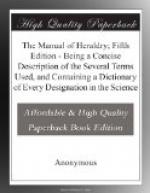[Illustration: Double Quatrefoil]
Should either of the nine brothers have male children, the eldest child would place the label on the difference that distinguished his father; the second son would place the crescent upon it; the third the mullet; continuing the same order for as many sons as he may have.
The label only, is used in the arms of the royal family as a difference; but the points of the label are charged with different figures to distinguish the second and succeeding sons. The arms of the sons of King George III. were thus distinguished: the shield of the arms of the Prince of Wales by a label; the Duke of York’s by the label, the centre point of which was charged with a red cross; that of the Duke of Clarence by a label, the dexter and sinister points of which were charged with an anchor, the centre point with the red cross; each of the succeeding sons were differenced by charges on the points of the labels.
All the figures denoting differences are also used as perfect charges on the shield; but their size and situation will sufficiently determine whether the figure is used as a perfect coat of arms, or is introduced as a difference or diminution.
Sisters have no differences in their coats of arms. They are permitted to bear the arms of their father, as the eldest son does after his father’s decease.
Guillim, Leigh, and other ancient armorists mention divers figures, which, they assert, were formerly added to coats of arms as marks of degradation for slander, cowardice, murder, and other crimes, and to them they give the name of abatements of honour; others have called them blots in the escutcheon: but as no instance can be produced of such dishonourable marks having been borne in a coat of arms, they may justly be considered as chimerical, or at any rate obsolete, and unworthy of consideration at the present time. Porney pithily observes, “that arms being marks of honour, they cannot admit of any note of infamy, nor would any one bear them if they were so branded. It is true, a man may be degraded for divers crimes, particularly high treason; but in such cases the escutcheon is reversed, trod upon, and torn in pieces, to denote a total extinction and suppression of the honour and dignity of the person to whom it belonged.”
The only abatement used in heraldry is the baton: this denotes illegitimacy. It is borne in the escutcheons of the dukes that assume the royal arms as the illegitimate descendants of King Charles the Second.
[Illustration: Baton]
CHAP. IV.
HONOURABLE ORDINARIES.
Honourable ordinaries are the original marks of distinction bestowed by sovereigns on subjects that have become eminent for their services, either in the council or the field of battle. Volumes have been written upon the origin and form of the honourable ordinaries. These long and tedious inquiries can only be interesting to antiquaries: it is sufficient for the tyro in Heraldry to know that they are merely broad lines or bands of various colours, which have different names, according to the place they occupy in the shield; ancient armorists admit but nine honourable ordinaries—the chief, the pale, the bend, the bend sinister, the fess, the bar, the chevron, the cross, and the saltier.




